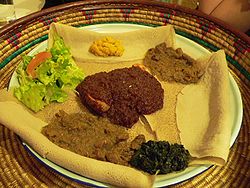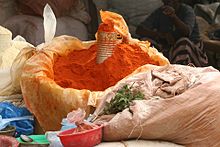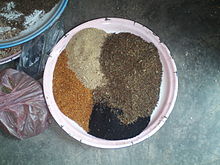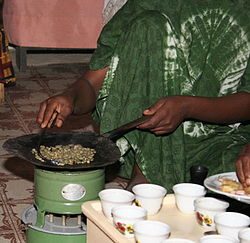- Ethiopian cuisine
-
Ethiopian cuisine and Eritrean cuisine characteristically consist of spicy vegetable and meat dishes, usually in the form of wat (or wot), a thick stew, served atop injera, a large sourdough flatbread[1], which is about 50 centimeters (20 inches) in diameter and made out of fermented teff flour.[1] Ethiopians eat with their right hands, using pieces of injera to pick up bites of entrées and side dishes.[1] Utensils are rarely used with this dish.
The Ethiopian Orthodox Church prescribes a number of fasting (tsom Ge'ez: ጾም ṣōm) periods, including Wednesdays, Fridays, and the entire Lenten season, so Ethiopian cuisine contains many dishes that are vegan (Amharic: ye-tsom የጾም ye-ṣōm, Tigrinya: nay-tsom ናይጾም nāy-ṣōm). This has also led Ethiopian cooks to develop a rich array of cooking oil sources: besides sesame and safflower, Ethiopian cuisine also uses nug (also spelled noog, known also as niger seed).[2]
Contents
Types of Ethiopian cuisine
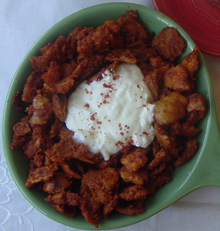 Fit-fit made with kitcha (unleavened bread), niter kibbeh (seasoned clarified butter) and berbere spice mixture is a typical breakfast food
Fit-fit made with kitcha (unleavened bread), niter kibbeh (seasoned clarified butter) and berbere spice mixture is a typical breakfast food
Ethiopian cuisine mostly consists of breads, stews (known as Wat), grains, and spices. Typically, an Ethiopian meal consists of a combination of injera (flatbread) with different wats, yet each diverse cultural group has their unique variation. A typical snack would be baked small pieces of bread called dabo kollo or local grains called kollo. Pasta is frequently available throughout Ethiopia, including rural areas.[1] Coffee is also a large part of Ethiopian culture/cuisine, after every meal a coffee ceremony is enacted and espresso coffee is drunk.
Berbere, a combination of powdered chili pepper and other spices (somewhat analogous to Southwestern American chili powder), is an important ingredient used in many dishes. Also essential is niter kibbeh, a clarified butter infused with ginger, garlic, and several spices.
Wat stews all begin with a large amount of chopped red onions, which are simmered or sauteed in a pot. Once the onions have softened, niter kebbeh (or, in the case of vegan dishes, vegetable oil) is added. Following this, berbere is added to make a spicy keiy (Amharic: ቀይ ḳey, Tigrinya, Ge'ez: ቀይሕ ḳeyyiḥ; "red") wat, or may omit the berbere for a milder alicha wat or alecha wat (Amharic: አሊጫ ālič̣ā). In the event that the berbere is particularly spicy, the cook may elect to add it before the kibbeh or oil so the berbere will cook longer and become milder. Meat such as beef (siga, Ge'ez: ሥጋ śigā), chicken (Amharic: ዶሮ dōrō, Tigrinya: ደርሆ derhō), fish (Amharic: asa), goat or lamb (Amharic: beg, Tigrinya በግዕ beggiʻ) is added; legumes such as split peas (Amharic: ክክ kik, Tigrinya: ክኪ kikkī) or lentils (Amharic: ምስር misir, Tigrinya: ብርስን birsin); or vegetables such as potatoes (dinich, Amharic: ድንች dinič, Tigrinya ድንሽ diniš), carrots and chard (Tigrinya: costa) are also used in wat.
Tibs
Meat or vegetables are sautéed to make tibs (also tebs, t'ibs, tibbs, etc., Ge'ez ጥብስ ṭibs). Tibs is served normal or special, "special tibs" is served on a hot dish with vegetables (salad) mixed in. The mid-18th century European visitor to Ethiopia, Remedius Prutky, describes tibs as a portion of grilled meat served "to pay a particular compliment or show especial respect to someone."[3]
Kitfo
Another distinctive Ethiopian dish is kitfo (frequently listed as ketfo), which consists of raw (or rare) ground beef marinated in mitmita (Ge'ez: ሚጥሚጣ mīṭmīṭā, a very spicy chili powder) and niter kibbeh. Gored gored is very similar to kitfo, but uses cubed, rather than ground, beef.
Breakfast
Firfir or fitfit, (Ge'ez: ፍርፍር firfir; ፍትፍት fitfit) made from shredded injera with spices, is a common breakfast dish. Another popular breakfast food is dulet (Ge'ez: ዱለት dūlet), a spicy mixture of tripe, liver, beef, and peppers with injera. Fatira consists of a large fried pancake made with flour, often with a layer of egg, eaten with honey. Chechebsa (or kita firfir) resembles a pancake covered with berbere and kibbeh, or spices, and may be eaten with a spoon.
Snacks
Kolo is a roasted barley snack food often served in a paper cone.[1] Snacking on Popcorn is also common.[1]
Beverages
Tej is a potent honey wine,[1] similar to mead, that is frequently served in bars (in particular, in a tej bet; Ge'ez ጠጅ ቤት ṭej bēt, "tej house"). katikala and araki are inexpensive local spirits that are very strong.
Tella is a home-brewed beer served in bars, which are also called "buna bets" (coffee houses).
Coffee (buna) holds a legitimate claim as originating from Ethiopia,[1] where it is a critical component of the economy[4] and is a central part of Ethiopian beverages. Equally important is the coffee ceremony which accompanies the serving of the coffee, which is sometimes served from a jebena (ጀበና), a clay coffee pot in which the coffee is boiled. The preparer roasts the coffee beans, then walks around the room so participants may sample the scent of coffee. Then the preparer grinds the coffee using a traditional tool called a mokecha. The coffee is put in to the jebena, boiled with water, and then served with small cups called si'ni. Coffee is usually served with sugar but is also served with salt in many parts of Ethiopia. Snacks such as popcorn or barley may be served with the coffee. In most homes a dedicated coffee area is surrounded by fresh grass, with special furniture for the coffee maker. A complete ceremony has three rounds of coffee (Abon, Tona Bereka) and is accompanied by the burning of frankincense.
Ambo is a bottled carbonated mineral water, sourced from the town of Ambo.[1]
Serving style
A mesob (Ge'ez: መሶብ mesōb) is a tabletop on which food is traditionally served. The mesob is usually woven from straw, and has a lid kept on it until the mealtime. Just before the food is ready, a basin of water and soap is brought out for hand-washing. When the food is ready, the top is taken off the mesob and the food is placed in the sunken top of the mesob. When the meal is finished, the basin of water and soap is brought back out for hand-washing again.
Gurage dishes
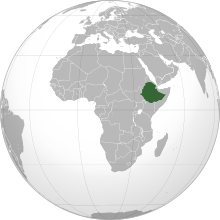 Location of Ethiopia
Location of Ethiopia
Gurage cuisine additionally makes use of the false banana plant (enset, Ge'ez: እንሰት inset), a type of ensete. The plant is pulverized and fermented to make a bread-like food called qocho or kocho (Ge'ez: ቆጮ ḳōč̣ō), which is eaten with kitfo.[5] The root of this plant may be powdered and prepared as a hot drink called bulla (Ge'ez: ቡላ būlā), which is often given to those who are tired or ill. Another typical Gurage preparation is coffee with butter (kebbeh).
The most popular Gurage main dish is kitfo. Gomen kitfo is another dish prepared in the occasion of Meskel, a very popular holiday marking the discovery of the True Cross. Collard greens (ጎመን gōmen) are boiled, dried and then finely chopped and served with butter, chili and spices.
Goorsha
A goorsha is an act of friendship. As stated above, a person uses his or her right hand to strip off a piece of injera, roll it in the wat or kitfo, and then put the rolled injera into his or her mouth. During a meal with friends, a person may strip off a piece of injera, roll it in the sauce, and then put the rolled injera into a friend's mouth. This is called a goorsha, and the larger the goorsha, the stronger the friendship.[6]
References
- ^ a b c d e f g h i Javins, Marie. "Eating and Drinking in Ethiopia." Gonomad.com. Accessed July 2011.
- ^ Paul B. Henze, Layers of Time: A history of Ethiopia (New York: Palgrove, 2000), p. 12 and note
- ^ J.H. Arrowsmith-Brown (trans.), Prutky's Travels in Ethiopia and other Countries with notes by Richard Pankhurst (London: Hakluyt Society, 1991), p. 286
- ^ "Ethiopia". The World Factbook. Central Intelligence Agency. 2011-01-12. https://www.cia.gov/library/publications/the-world-factbook/geos/et.html. Retrieved 2011-01-31.
- ^ "Uses of Enset" (HTML). The 'Tree Against Hunger': Enset-Based Agricultural Systems in Ethiopia. American Association for the Advancement of Science. 1997. http://www.aaas.org/international/africa/enset/uses.shtml. Retrieved 2007-08-13.
- ^ Selinus, Ruth (1 January 1971). "The Traditional Foods of the Central Ethiopian Highlands (research report no. 7)". EthnoMed. http://ethnomed.org/clinical/nutrition/the-traditional-foods-of-the-central-ethiopian. Retrieved 1 November 2009.
External links
- An extensive website about Ethiopian food and culture, includes Ethiopian restaurants listings and customers' reviews.
- Mesob Across America: Ethiopian Food in the U.S.A. A book about the history and culture of Ethiopian cuisine
- Ethiopian Food: Mesob Across America A blog about Ethiopian food
- Ethiopian Restaurant Guide Includes video visits to some restaurants
- All About Tej An extensive website about the Ethiopian honey wine
- Raw Meat, a Manly Ethiopian Dish The Los Angeles Times, July 14, 2011
- Ethiopian Restaurants: Worldwide Listing
- Eating and Drinking in Ethiopia
- Spicy Food from the Cradle of Civilization
- Injera recipe Injera is a traditional Ethiopian bread
- Ethiopian-inspired Cuisine Ethiopian food has spawned Western counterparts
- Ethiopia: Coffee History, Production, Economy facts
- Ethiopian Coffee Ceremony from Epicurean.com
- Ethiopian Coffee Ceremony
 Ethiopia topics
Ethiopia topicsRegions History Demographic · Economic · Military
Timeline · Early · Kingdom of Dʿmt · Kingdom of Aksum · Zagwe Dynasty · Abyssinian-Adal War · Zemene Mesafint · Second Italo-Abyssinian War · East African Campaign · Derg · Ethiopian Civil War · Ogaden WarEconomy History · Transport · Communications · Agriculture · Energy · Foreign aid · Industrial development · Land reform · Manufacturing · Trade Unions · Companies · Ethiopian Birr · Banks · Taxation · International rankingsPolitics · Military Constitution (history) · President · Prime Minister · Foreign relations · Foreign Aid · Ethiopian National Defense Force · Ethiopian Air Force · Ethiopian Navy · Military history · Human rights · LGBT rightsGeography
DemographicsCulture Art · Cuisine · Education · Ethiopian Christianity · Literature · Media · Music · Public Holidays · SportAfrican cuisine National cuisines - Algeria
- Angola
- Benin
- Botswana
- Burkina Faso
- Burundi
- Cameroon
- Cape Verde
- Centrafrican (Central African Republic)
- Chad
- Comoros
- The Republic of the Congo
- The Democratic Republic of the Congo
- Egypt
- Eritrea
- Ethiopia
- Gabon
- Ghana
- Ivorian (Côte d'Ivoire)
- Kenya
- Libya
- Madagascar
- Morocco
- Mozambique
- Namibia
- Nigerien (Niger)
- Nigerian
- Rwanda
- Senegal
- Sierra Leone
- Somalia
- South Africa
- Sudan
- Swaziland
- Tanzania
- Tunisia
- Uganda
- Zambia
- Zimbabwe
Ethnic and regional cuisines Categories:
Wikimedia Foundation. 2010.

